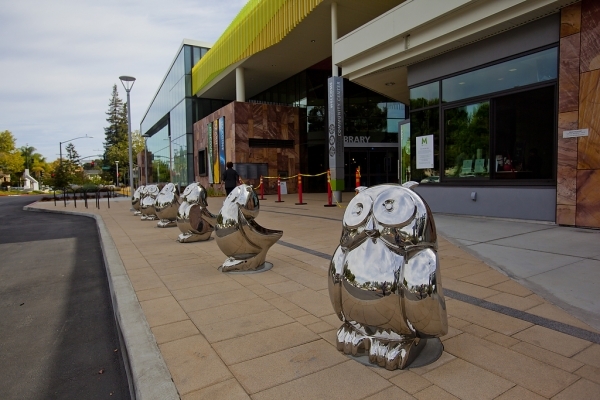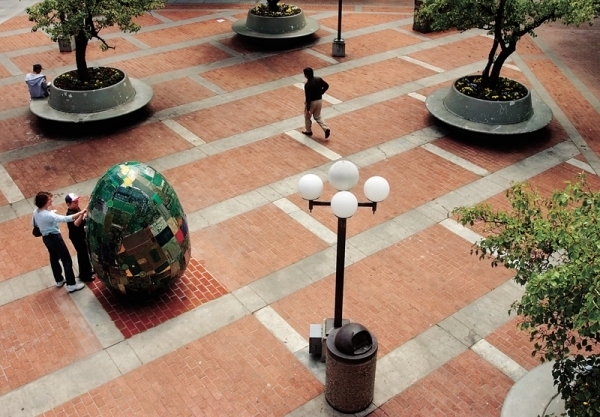When people think about public art, they often think of things like the egg-shaped "Digital DNA" sculpture at Lytton Plaza or the shiny owl bollards vigilantly guarding the entrance to the new Mitchell Park Library and Community Center.
Under a new proposal to revise the city's "percent for public art program," the term could soon take on a host of new meanings. The revisions, which the City Council Policy and Services Committee unanimously supported on Dec. 16, would require that all sorts of projects, including bridge, parks, walls and tunnels, have a public art component.
The revisions would apply to the city's decade-long policy of requiring municipal capital projects to devote 1 percent of their budgets to public art (the city last year adopted a similar requirement for private developments). If approved, the changes would make the policy apply to more projects and allow the city to pool funds from various small projects to pay for a single work of art.
One problem that the revisions seek to solve is the difficulty staff currently has in figuring out which projects are eligible and which aren't. While new buildings such as the Mitchell Park Library are clearly eligible, things get thornier when one considers transportation and utility projects.
Elise DeMarzo, the city's public art manager, noted that the general language in the existing policy requires staff to engage in lengthy consultations with various departments to figure out whether and how to apply the policy.
Many projects, such as the renovation of the Charleston/Arastradero corridor, landscaping projects and various park rehabilitations, did not receive percent-for-art allocations, despite their "large visual impact," DeMarzo said. The council committee agreed with staff's position that perhaps these types of projects should have been required to have an art component.
The revised policy (which only applies to public projects), includes a list of a dozen projects that are specifically exempt from the art requirement, including things like seismic upgrades, roof replacements and emergency-repair projects.
If the revisions were in effect this year, the percent-for-art policy would apply to about $10 million worth of projects in the city's $25-million capital improvement fund budget (the remaining $15 million are mostly sidewalk and street repairs, as well as salaries and benefits of workers supporting the projects). It would have netted about $92,408 for public art, well above the $30,300 that was allocated this year through the policy.
With the revisions, the policy would apply "to all CIP projects," aside from those that fall into the exempted categories. This includes buildings, garages, shelters, restrooms, parks, medians, landscaping, plazas, gateways, bridges, walls, tunnels and streets. The policy will also specify that the council and city manager will have the option of allocating funds for art for "exempt" projects. This, in effect, gives the city flexibility to add an art component to just about any public project that the city is undertaking.
The revisions would broaden a policy that has applied to municipal projects since 2005. Last year, the council extended the percent-for-art requirement to private developments.
The revised ordinance states that "public art fosters economic development, enhances community vitality and enriches the quality of life through the city." With the revision, the city wishes to "confirm and strengthen its municipal public art program to enhance the funds available for public art and to increase flexibility to provide art experiences that are timely and relevant throughout the community."
DeMarzo said the new, broader public art requirement "isn't meant to be putative," but is aimed toward "capturing projects where there is an opportunity."
Another revision that the committee signed off would enable staff to pool funds from various projects toward a single work of art and allow the city to spend these funds on public art "at any appropriate site within the city."
Gail Price joined her colleagues in arguing that staff and the council should have the leeway to apply the requirement even to projects that would be exempted under the revised policy.
All four committee members -- Price, Larry Klein, Greg Scharff and Greg Schmid -- enthusiastically supported the revisions. Scharff suggested that certain utility projects (such as utility boxes) should be subject to the policy and was assured that staff will have leeway to make that requirement in the future.
City Manager James Keene agreed that the requirement should be considered broadly and cited "Streaming," an artwork by Ceevah Sobel that the city installed at the San Francisquito Creek.
"When we built a pump station near the creek, we built an art component that made it kind of distinctive," Keene said. "I'm not sure that in reservoirs and things like that, that we wouldn't want to think about a public art component."
"I think it is prudent to add language that allows some exceptions to the exceptions," Price added. "There may be projects that we are not covering by the language or new opportunities that come up that may be perfectly well suited for this kind of artistic enhancement. I think that it is prudent to provide us that flexibility."




Comments
Another Palo Alto neighborhood
on Dec 24, 2014 at 8:26 am
on Dec 24, 2014 at 8:26 am
More requirements added to "the Palo Alto Way."
Palo Verde
on Dec 24, 2014 at 8:50 am
on Dec 24, 2014 at 8:50 am
These are people who clearly don't have enough to do.
Another Palo Alto neighborhood
on Dec 24, 2014 at 8:57 am
on Dec 24, 2014 at 8:57 am
Really???????
What is worse, the council discussing this or the Weekly for writing such a long report.
A bit of common sense is all that is needed.
Now if it were a discussion to do the upkeep of the Baylands Boardwalk and Interpretive Center, we don't need any art because there is plenty of natural beauty there anyway. However, I think the council wants to ignore upkeep of areas of natural beauty and instead put ugly monstrosities near buildings that should be as invisible as possible.
South of Midtown
on Dec 24, 2014 at 11:31 am
on Dec 24, 2014 at 11:31 am
I saw those excessively shiny owls for the first time and looked at them carefully to see what they were for. The backs look like they could be seats but are too slanted and wont work. Eyecatching and ridiculous. And expensive.
They are only one example of the bad taste and big expensive signage in that bloated cavernous structure. No matter how many times the City Manager tells us how wonderful it is, you can judge for yourself what a big, big, tasteless waste of money it is.
Another Palo Alto neighborhood
on Dec 24, 2014 at 1:25 pm
on Dec 24, 2014 at 1:25 pm
I actually like the shiny owls at the new library. They are great eye catchers and children enjoy them. I think they are good for perching on rather than sitting for a long time.
Much better than the hideous looking pile of lego bricks by the parking lot. Shows exactly what public art is supposed to be, some suit one person's taste and some suit others. As long as they don't rust or cause an accident. I am happy enough with them.
But, a library is a place to find some art.
Utility boxes is not.
Registered user
another community
on Dec 24, 2014 at 1:40 pm
Registered user
on Dec 24, 2014 at 1:40 pm
we need a few more of those giant twisted paper clips that are all up and down ECR
Downtown North
on Dec 24, 2014 at 2:12 pm
on Dec 24, 2014 at 2:12 pm
"When people think about public art, they often think of things like the egg-shaped "Digital DNA" sculpture at Lytton Plaza"
I try not to think about that pile of hazardous waste (lead, mercury, etc,). Likewise our city officials.
another community
on Dec 24, 2014 at 4:58 pm
on Dec 24, 2014 at 4:58 pm
> "Elise DeMarzo, the city's public art manager, noted that the general language in the existing policy requires staff to engage in lengthy consultations with various departments to figure out whether and how to apply the policy."
For which she gets paid $102,000/year.
Web Link page xvi
Another Palo Alto neighborhood
on Dec 26, 2014 at 7:17 am
on Dec 26, 2014 at 7:17 am
The City staff should take field trips around the Bay Area, like Menlo
Park for example, and down to San Diego and look at La Jolla Blvd to
see how other communities handle street signage, street markings,and
other streetscape modifications which are effective and don't completely
detroy the character and ambiance of the district or neighborhood.